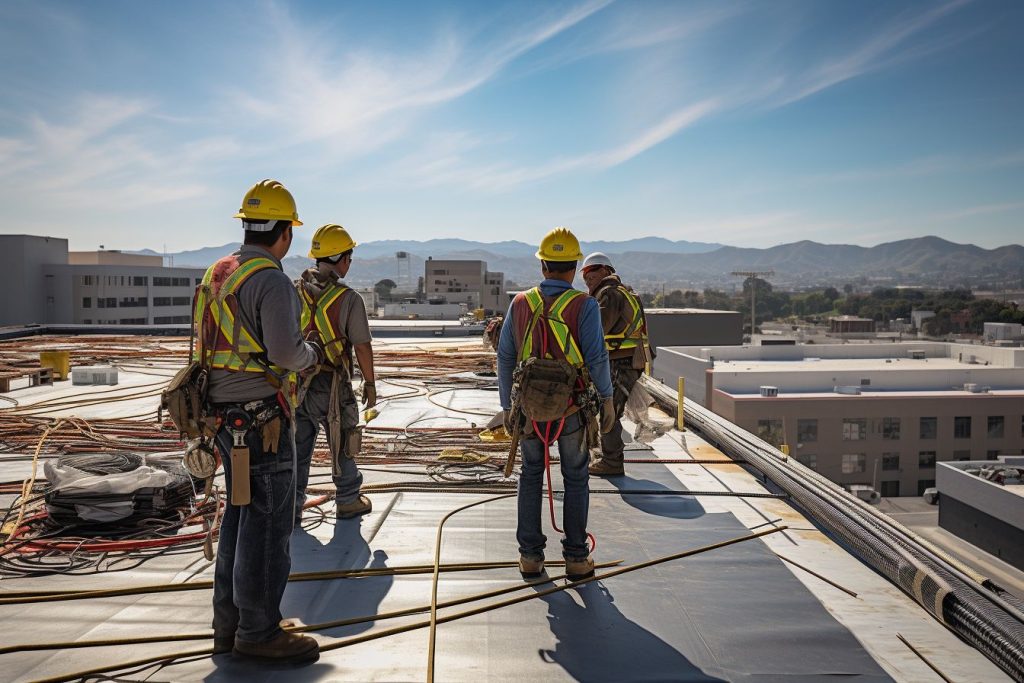Working on commercial rooftops can pose a myriad of safety issues, making it critical to adhere to defined procedures. Studies show that most roofing accidents are preventable with the proper precautions and safety measures in place.
This article offers an extensive guide on best practices for commercial roof safety, helping you maintain a safe environment for all workers. Would you be ready to step up your rooftop game? Read on!
Key Takeaways
- Implement the buddy system to enhance workplace safety on commercial roofs and reduce injury risks.
- Maintain constant communication and conduct regular 15-minute safety checks to detect potential dangers early and ensure adherence to safety protocols.
- Control access to commercial roofs by permitting only authorised individuals with proper training and protective gear.
- Schedule regular inspections to identify hazards, assess equipment condition, and prevent accidents before they happen.
- Adhere to the 15′ Rule by not accessing the roof without a proper inspection within 15 feet of the work area to reduce fall risks.
- Establish rooftop rescue plans for emergencies, ensuring quick response and worker protection in case of accidents or incidents on the roof.
- Use personal fall arrest systems, guardrail systems, safety net systems, warning lines, and proper marking of skylights and openings as essential safety measures on commercial roofs.
- Take extra precautions in hot weather (e.g., lightweight clothing) and cold weather (e.g., layering up with insulated clothing) to protect workers from heat-related illnesses or falls on icy surfaces.
Essential Safety Precautions
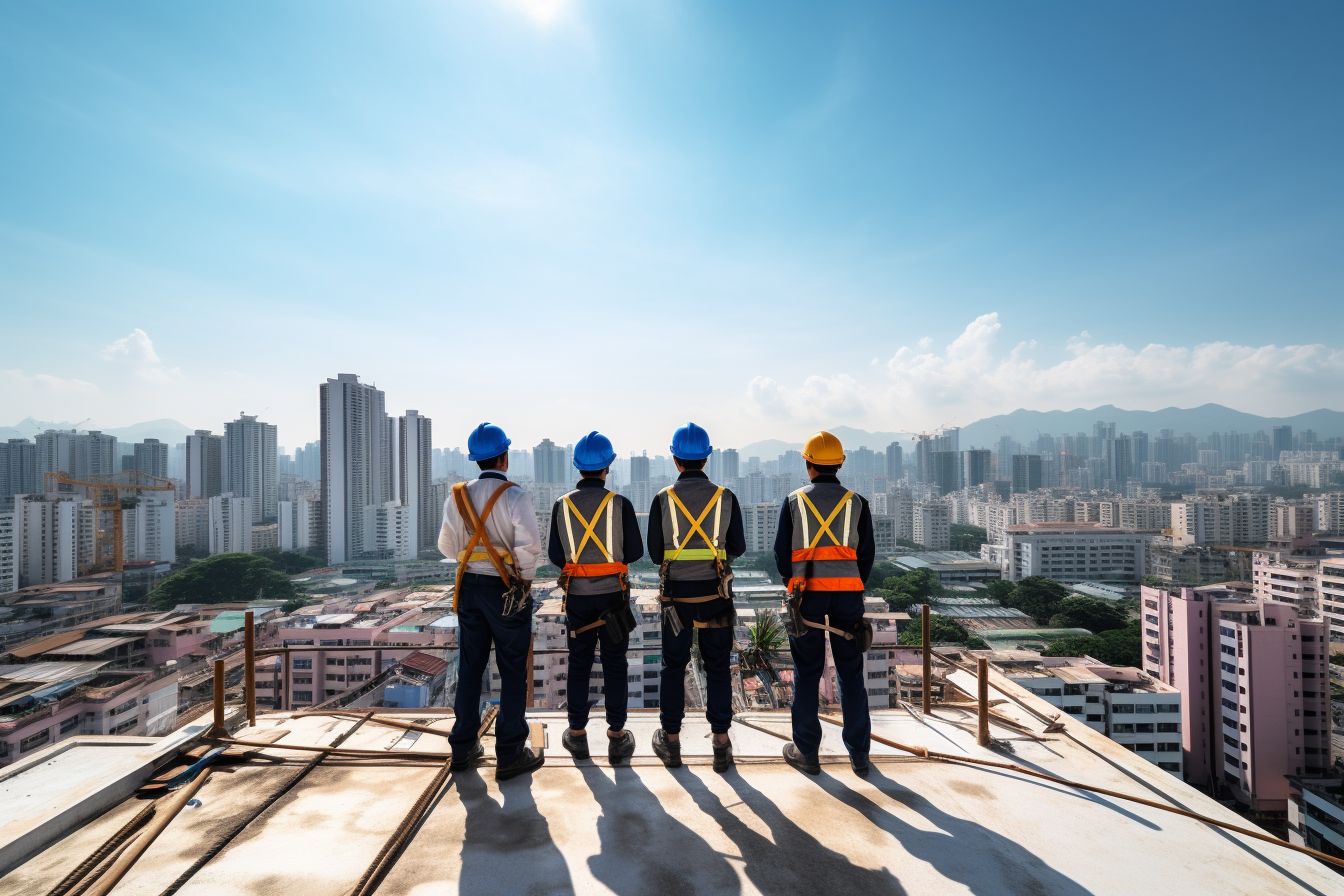
Implementing the buddy system and conducting regular communication and safety checks are crucial for ensuring commercial roof safety.
The Buddy System
The buddy system pairs workers up to enhance workplace safety on commercial roofs. Two individuals team up, monitoring each other’s well-being throughout the workday. This essential safety precaution is a proactive approach towards accident prevention, significantly lowering injury risks.
Common among OSHA regulations, this practice ties into the more extensive safety management framework in workplaces across America. The system fosters a sense of accountability and vigilance amongst employees while reducing safety incidents on hazardous sites like commercial roofs.
With everyone responsible for their partner’s protection, roofing projects can proceed with an added layer of security that single-worker systems often overlook.
Communication and 15 Minute Safety Checks
The lifeline of safety on a commercial roof begins with constant communication and diligent 15-minute safety checks. It is crucial to maintain contact between those working atop the building and someone stationed inside, making use of reliable communication tools.
This system ensures immediate relay of information and aids in efficient emergency management.
Rigorous 15-minute monitoring procedures are an effective way to keep rooftop hazards at bay. These recurring checks help detect potential dangers early, giving workers ample time to react accordingly.
Safety equipment usage and adherence to protocols are regularly validated during these intervals, cementing their role in enhancing roofing safety. Moreover, regular checks encourage ongoing training for workers, further boosting workplace safety standards.
Permitted Access
Permitted access ensures that only authorised entry is allowed on commercial roofs. Companies implement robust safety protocols, including a permitting process to maintain control over who has roof access.
This rule significantly deters non-trained individuals from accessing the hazardous environment of the roof structure. It’s crucial that only construction professionals or building maintenance personnel, equipped with appropriate knowledge and protective gear, step foot up there.
Compliance with OSHA regulations backs this practice for fall protection measures, further solidifying its importance in maintaining workplace safety standards. Incorporating cautionary signage serves as an additional layer of security, reminding everyone of potential risks and encouraging them to abide by all directives when on site.
Scheduled Inspections
Scheduled inspections are crucial to maintaining roof safety and ensuring workplace integrity. Regular maintenance checks help identify potential hazards, assess the condition of equipment, and prevent accidents before they happen.
During these inspections, ladders should be checked daily to ensure their stability and reliability. A professional inspector will evaluate various aspects of the roof using a 10-point checklist to ensure worker protection and adherence to safety guidelines.
By following proper protocols and conducting scheduled inspections, employers can prioritise worker safety and minimise risks associated with roof work.
15′ Rule
The 15′ Rule is a crucial safety requirement for anyone working on commercial roofs. According to this rule, workers should only access the roof with a proper inspection within 15 feet of their work area.
This ensures that potential hazards or safety issues are identified and addressed before tasks begin. Employers should enforce this rule by prohibiting workers from accessing the roof without a recent inspection.
Adhering to the 15′ Rule dramatically reduces the risk of falls, injuries, and other physical hazards associated with working at heights. It plays a vital role in maintaining workplace safety and preventing accidents in roofing projects.
Rooftop Rescue Plans
Employers must prioritise the safety of their workers by having a rooftop rescue plan in place for emergencies. This plan ensures a quick and effective response to any accidents or incidents on the roof.
With rooftop work often being out of sight from those overseeing safety precautions, having a rescue plan is crucial to protect workers from potential harm. Employers demonstrate their commitment to workplace safety and fall prevention by implementing this essential safety protocol.
It also helps comply with occupational safety regulations and guidelines, minimising risks associated with rooftop hazards.
When it comes to rooftop rescue plans, employers need to consider various factors, such as the layout of the roof, access points, and emergency procedures. These plans should outline specific responsibilities and actions that need to be taken in an emergency.
Safety Equipment and Measures
Safety equipment and measures are crucial for ensuring the protection of workers on commercial roofs, including using personal fall arrest systems, guardrail systems, safety net systems, warning lines, and proper marking of skylights and openings.
Personal Fall Arrest Systems
Personal Fall Arrest Systems are crucial for ensuring the safety of workers on commercial roofs. They are designed to distribute the impact of a fall through the thighs and buttocks, reducing the risk of serious injuries. These systems consist of three components: a harness, which the worker wears; an anchor point, which provides a secure attachment; and a lanyard or lifeline, which connects the harness to the anchor point. Some other vital components of personal fall arrest systems include harness straps, shock absorbers, snap hooks, D-rings, body belts, and roof anchors. These systems adhere to OSHA regulations and ANSI standards and protect workers from fall hazards.
Guardrail Systems
Guardrail systems play a crucial role in ensuring commercial roof safety. These smooth-surfaced barriers are designed to prevent clothing snagging and potential injuries. Here are some essential facts about guardrail systems:
- Guardrail systems provide an effective means of protecting workers from falls at heights.
- Compliance with OSHA guardrail requirements is essential for building guardrails that meet safety standards.
- Guardrails can be installed around roof edges, stairwells, and other areas where fall protection is needed.
- Safety regulations, such as OSHA’s 15′ rule, emphasise the importance of adequate guardrails.
- Roof hatch guardrails are available to create a secure working environment for workers accessing rooftop openings.
Safety Net Systems
Safety net systems play a crucial role in ensuring commercial roof safety. These passive fall protection systems are designed to prevent falls or catch workers beneath work areas. As industry guidelines and regulations recommend, they are classified as safety equipment and preventive measures for rooftop work and repairs. Employers must ensure that employees are protected from falls with fall protection systems like safety nets.
- Safety nets can be installed as a barrier to prevent falls or as a catch system for workers in the event of a fall.
- Safety net systems help prevent physical injuries, hazardous substance exposures, and illnesses when working on commercial roofs.
- They are essential to implementing commercial roof safety guidelines and ensuring employee protection.
- Safety net systems are considered best practices in maintaining work area safety and preventing falls.
- Along with other safety measures such as personal fall arrest systems, guardrail systems, and warning lines, safety net systems contribute to a comprehensive approach to commercial roof safety.
Warning Lines
Warning lines play a crucial role in commercial roofing safety. These lines are set up around the roof’s perimeter to alert workers about unprotected areas and prevent falls and injuries.
Employers enforce rules that prohibit workers from going beyond warning lines, usually set at a distance of 15 feet. Combined with guardrails, warning lines create a designated walkway for workers, ensuring their safety while on the roof.
OSHA guidelines require regular inspection and maintenance of these warning line systems to ensure their effectiveness in preventing accidents.
Marking Skylights and Openings
Skylights and roof openings can pose a significant risk to workers, increasing the chances of fatal falls and serious injuries. Unprotected skylights, in particular, are considered a significant fall protection hazard.
To mitigate these risks, employers must adhere to OSHA regulations, which require covers or guardrail systems around skylights, roof hatches, and any hole four feet or more above a lower level.
Marking these areas with clear signage and colour-coded markings can also help alert workers about potential hazards. By consistently marking skylights and openings, employers can enhance worker safety and prevent accidents in the roofing industry.
Weather Considerations
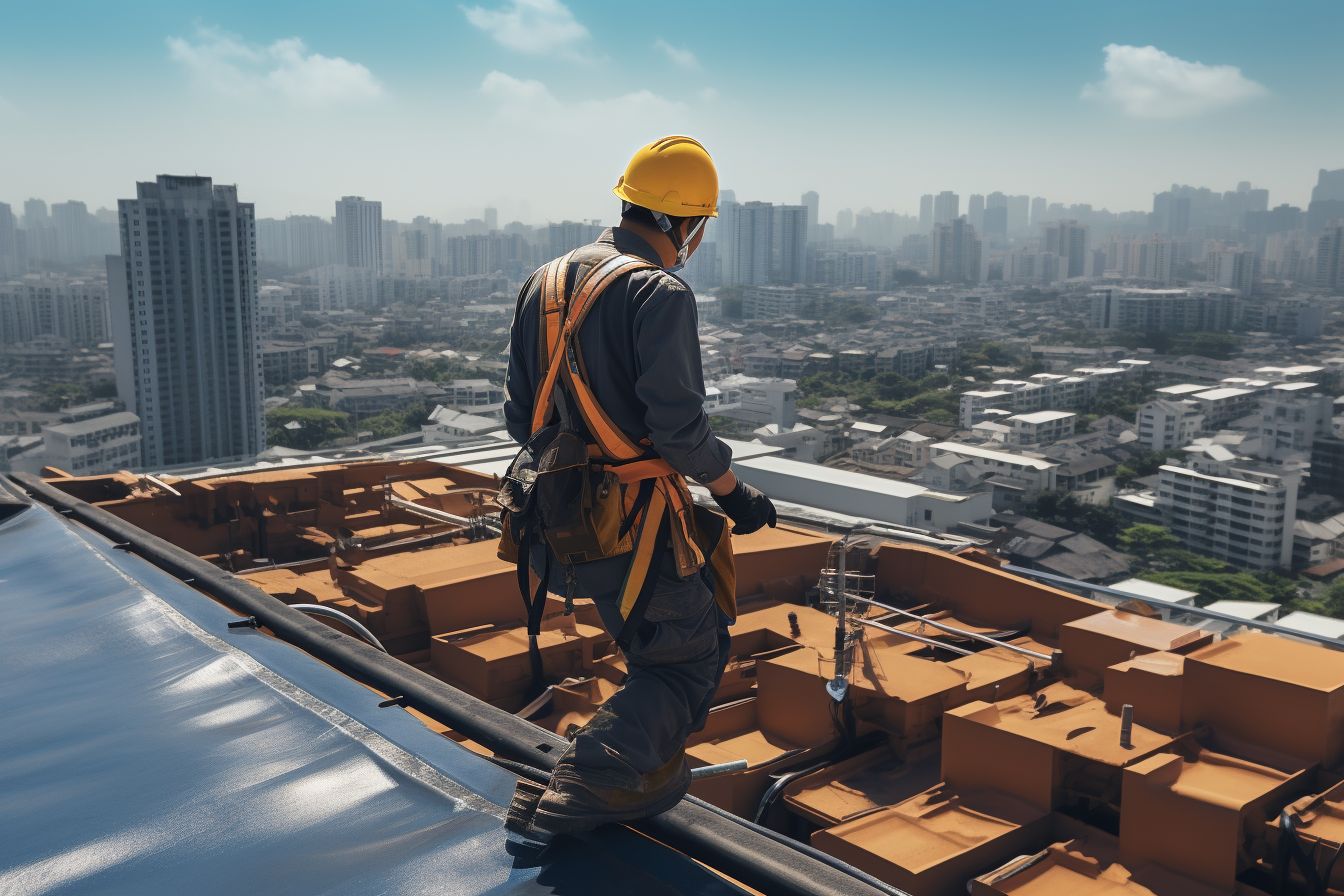
Extra precautions should be taken in both hot and cold weather to ensure the safety of workers on commercial roofs.
Extra Precautions in Hot and Cold Weather
Roofers must take extra precautions in hot and cold weather to ensure safety. In hot weather, it’s essential to wear lightweight, breathable clothing and stay hydrated to prevent heat exhaustion or heat stroke.
Applying sunscreen and wearing wide-brimmed hats can protect against sunburn and heat-related illnesses. On the other hand, in cold weather, roofers should layer up with insulated clothing to provide warmth while also ensuring breathability.
Wearing safety harnesses and non-slip boots prevents slips and falls on icy surfaces. Roofers must also be aware of concealed dangers such as skylights hidden under snow-covered rooftops or electrical hazards that may be present during winter construction.
Taking extra care by moisturising exposed skin regularly can help prevent frostbite, while proper hydration will combat fatigue and dehydration caused by cold temperatures. Implementing these extra precautions helps keep roofers safe in extreme weather conditions.
How to Maintain a Commercial Roof
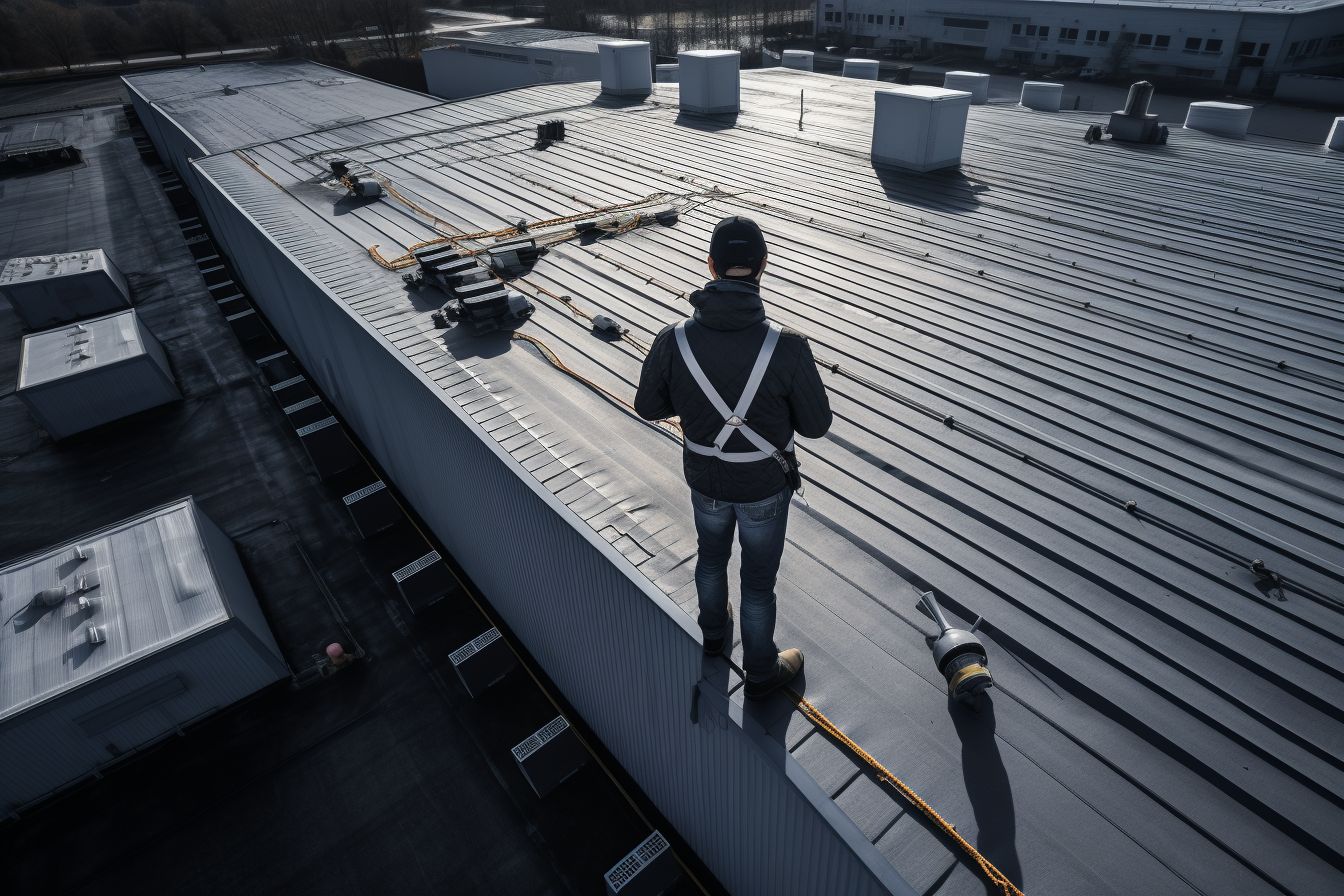
Regular maintenance is vital to ensuring the safety and functionality of a commercial roof. Here are some critical steps to take to maintain your commercial roof effectively:
- Conduct regular inspections to identify any signs of damage or deterioration.
- Clean the roof regularly to remove debris, leaves, and other materials that can cause clogs or damage.
- Address any repairs promptly to prevent further damage and ensure the roof’s integrity.
- Keep detailed records of all maintenance activities performed on the roof for future reference.
- Hire professional contractors with expertise in commercial roofing for thorough inspections, cleaning, and repairs.
Conclusion
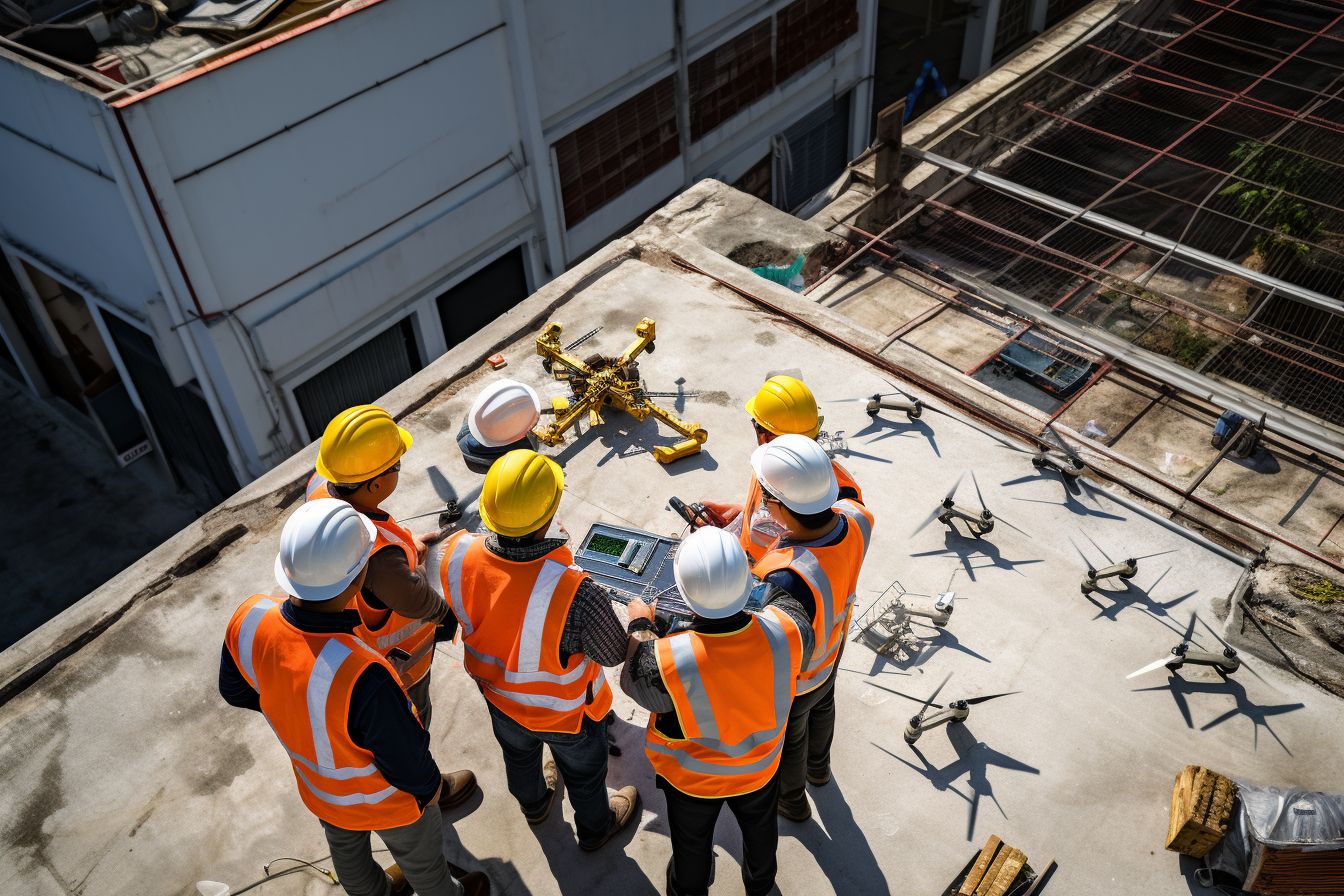
In conclusion, implementing best practices for commercial roof safety is crucial to protect workers and prevent accidents. Roofing contractors can create a safe working environment on rooftops by following safety precautions, using appropriate equipment, and maintaining regular inspections.
Employers should also ensure that their workers receive proper training and adhere to OSHA regulations to promote a culture of safety on commercial roofs.
FAQs
1. What are the best practices for commercial roof safety?
The best practices for commercial roof safety include using proper fall protection equipment, conducting regular inspections and maintenance, training workers on safe working procedures, and implementing a comprehensive safety plan.
2. How often should I inspect my commercial roof for safety?
I’d like to point out that you should look over your commercial roof at least twice a year or after any severe weather events, so I’d appreciate it if you could identify potential hazards and address them quickly.
3. What kind of fall protection equipment should be used on a commercial roof?
Fall protection equipment such as harnesses, lanyards, anchors, guardrails, and warning lines should be used on a commercial roof to prevent falls and ensure worker safety.
4. Are there any specific training requirements for working safely on a commercial roof?
Yes, workers should receive proper training on safe work practices related to roofing tasks, including using personal protective equipment (PPE), recognising potential hazards, and performing emergency procedures.
5. What are the consequences of not following best practices for commercial roof safety?
Not following best practices for commercial roof safety can result in serious injuries or fatalities due to falls from heights. It can also lead to legal penalties, financial losses from lawsuits or insurance claims, damage to property or equipment, and decreased productivity due to accidents or downtime caused by unsafe conditions.

